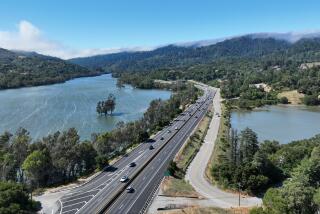Study Lists City’s Most Perilous Intersections
- Share via
The San Diego traffic engineering office has identified the city’s most dangerous intersections, and the Sports Arena area tops the list.
In a report issued this week to the City Council, traffic engineers listed the 20 city intersections with the most accidents and the 20 intersections with the highest accident rates during 1986.
Six of the intersections with the most accidents were in the Sports Arena area. The top five are Midway Drive and Rosecrans Street (41 accidents in 1986), Garnet Avenue and Mission Bay Drive (33), 40th Street and El Cajon Boulevard (32), Rosecrans Street and Sports Arena Boulevard (27), and 19th Street and Palm Avenue (27).
But it’s not quite right to refer to them as the “worst” intersections in the city, said Bruce Herms, city traffic engineer.
“We hesitate to say ‘worst’ because we don’t know which are the worst,” Herms said.
The department judges intersections on both the total number of accidents and the rate of accidents, which is the number of accidents per million cars. An intersection with a large number of accidents may have a low accident rate if it has a high traffic flow.
Based on the rate of accidents, the worst intersection in the city is 26th and Commercial streets (7.6 accidents per million cars). Rounding out the top five are Cable Street and Niagara Avenue (4.3) and Cable Street and Narragansett Avenue (4.2), both in Ocean Beach; Cedar Street and Kettner Boulevard (4) downtown, and Bayard and Felspar streets (3.8) in Pacific Beach. None of these intersections appeared on the 1985 report.
The citywide accident surveillance program was started in 1982 at the request of the council’s Public Services and Safety Commission. The city calculates the number of accidents and accident rates by interpreting information from more than 25,000 police reports and monitoring various intersections year-round.
The accident survey does not include accidents not reported to police, nor does it take into account the severity of accidents, according to Phil Sanford, associate traffic engineer and project engineer. A fender-bender and a multiple-fatality crash are tallied the same way.
The traffic engineering office uses this information to identify heavily congested areas and emerging traffic patterns so that intersections can be made safer.
Compared to 1985, the number of accidents in the 1986 top 20 list dropped by 22%.
Linda Vista Road and Napa Street was No. 2 on the list for 1985. After the 1985 report was issued, the city changed the position of its traffic lights, and the intersection dropped to seventh in 1986. At the worst intersection on the 1985 list, signal positions were changed, and Garnet Avenue and Mission Bay Drive has dropped to second on the current list.
At 16th and F streets, ranked seventh in 1985, the city made adjustments in signal positions after engineers found that several accidents were caused by people running red lights. That intersection did not make the 1986 top 20 list.
The No. 1 1986 intersection--Midway Drive and Rosecrans--held the third position in 1985. This intersection, part of California 209, is under California Department of Transportation jurisdiction.
“If we could design that all over again, we would never have so many streets coming into that intersection,” said Bill Dotson, Caltrans district director. “We already have a street pattern there and can’t really change it. The most we can do is take a look at traffic signals or reposition lanes, for example. And we can make it clear enough to the traveling public so they understand which way to turn and which lane they’re supposed to be in.”
Dotson said an increase in traffic through Midway Drive and Rosecrans was probably the reason for the increase in accidents from 1985 to 1986. The report notes that 70,000 vehicles go through it each day.
Dotson said the same is true for the fourth-ranked Balboa Avenue and Convoy Street, “which has the highest peaks of traffic anywhere for a city-street area.”
From the traffic engineering standpoint, the rate is more helpful than the total number of accidents in spotting a problem because “accidents tend to be proportional to the amount of traffic,” the report states.
In 1986 the highest accident rate by a wide margin was at 28th Street and Commercial Street.
There, the San Diego Trolley, which began operating in March, 1986, posed potential added problems, according to the report. The intersection was not on the 1985 list.
In 1985 the highest accident rate went to the Camino del Rio North and Milly Way intersection. When all-way stop control was provided in January, 1986, there was a significant drop in left-turn accidents, the report states. The same goes for 1985’s number two, Camino del Rio North and Stadium Way, which was given signals in November, 1985. Neither made the 1986 list.
Traffic engineer Sanford said improvements sometimes cause other problems.
“One thing I’ve found over the years is that new traffic signals reduce right-angle accidents, but tend to increase rear-end collisions,” he said.
“Another thing I’ve found is that drivers are normally much less aware of accidents than delays or congestion. A long wait usually causes them more concern.”
MOST ACCIDENTS These figures, from the staff of the San Diego city manager’s office, show the 20 intersections in the city with the highest number of accidents in 1986 and the number of accidents per million vehicles passing through those intersections.
Accidents Number Intersection per Million Cars of Accidents Midway Drive and Rosecrans Street 1.56 41 Garnet Avenue and Mission Bay Drive 1.01 33 40th Street and El Cajon Blvd. 1.47 32 Rosecrans Street and Sports Arena Blvd. 0.96 27 19th Street and Palm Avenue 1.19 27 40th Street and University Avenue 1.31 26 Linda Vista Road and Napa Street 1.75 25 Euclid Avenue and University Avenue 1.80 25 Mission Blvd. and W. Mission Bay Drive 1.90 25 Camino del Rio and Kurtz Street 1.06 24 43rd Street and University Avenue 1.98 24 Kurtz Street and Rosecrans Street 2.08 23 El Cajon Blvd. and Park Blvd. 1.45 22 Midway Drive and W. Point Loma Blvd. 1.16 22 Mission Blvd. and Pacific Beach Drive 1.64 22 Genesee Avenue and La Jolla Village Drive 0.95 22 Balboa Avenue and Kearny Villa Road 1.32 21 Nimitz Blvd. and I-8 1.89 21 6th Avenue and University Avenue 1.13 21 College Avenue and University Avenue 1.16 21
HIGHEST ACCIDENT RATES These figures, from the staff of the San Diego city manager’s office, show the 20 intersections in the city with the most accidents per million cars passing through the intersection in 1986.
Accidents Number Intersection per Million Cars of Accidents 26th and Commercial streets 7.63 11 Cable Street and Niagara Avenue 4.30 12 Cable Street and Narragansett Avenue 4.19 11 Cedar Street and Kettner Blvd. 3.97 11 Bayard and Felspar streets 3.81 8 G Street and Kettner Blvd. 3.55 9 9th Avenue and B Street 3.10 18 28th and Commercial streets 3.08 13 16th Street and Imperial Avenue 3.08 16 A and Columbia streets 2.94 9 Reo Drive and Valley Road 2.77 13 Fanuel and Felspar streets 2.72 9 4th and Brookes avenues 2.58 10 5th Avenue and B Street 2.57 17 La Jolla Colony Drive and I-5 2.53 10 Balboa Drive and El Prado 2.49 11 Swift Avenue and Wightman Street 2.37 8 16th Street and Broadway 2.37 14 30th Street and Imperial Avenue 2.36 12 5th Avenue and A Street 2.32 20
More to Read
Sign up for Essential California
The most important California stories and recommendations in your inbox every morning.
You may occasionally receive promotional content from the Los Angeles Times.










